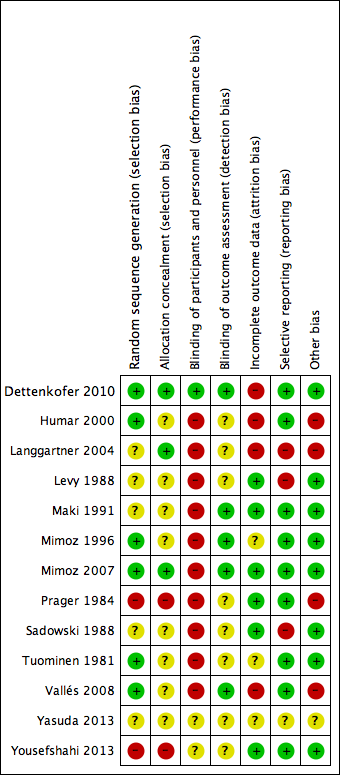Contenido relacionado
Revisiones y protocolos relacionados
Nai Ming Lai, Jacqueline E Taylor, Kenneth Tan, Yao Mun Choo, Azanna Ahmad Kamar, Nor Asiah Muhamad | 23 marzo 2016
Jo C Dumville, Emma McFarlane, Peggy Edwards, Allyson Lipp, Alexandra Holmes, Zhenmi Liu | 21 abril 2015
Gill Norman, Janice Christie, Zhenmi Liu, Maggie J Westby, Jayne M Jefferies, Thomas Hudson, Jacky Edwards, Devi Prasad Mohapatra, Ibrahim A Hassan, Jo C Dumville | 12 julio 2017
Nai Ming Lai, Nathorn Chaiyakunapruk, Nai An Lai, Elizabeth O'Riordan, Wilson Shu Cheng Pau, Sanjay Saint | 16 marzo 2016
Reineke A Schoot, Elvira C van Dalen, Cornelia H van Ommen, Marianne D van de Wetering | 25 junio 2013
Joan Webster, Donna Gillies, Elizabeth O'Riordan, Karen L Sherriff, Claire M Rickard | 4 mayo 2016
Nicole C Gavin, Joan Webster, Raymond J Chan, Claire M Rickard | 1 febrero 2016
Sharon R Lewis, Oliver J Schofield‐Robinson, Sarah Rhodes, Andrew F Smith | 30 agosto 2019
Zhenmi Liu, Gill Norman, Zipporah Iheozor‐Ejiofor, Jason KF Wong, Emma J Crosbie, Peter Wilson | 17 mayo 2017
Gill Norman, Ross A Atkinson, Tanya A Smith, Ceri Rowlands, Amber D Rithalia, Emma J Crosbie, Jo C Dumville | 30 octubre 2017
Podcast relacionado
Respuestas clínicas Cochrane
Jane Burch, Sera Tort | 23 mayo 2017


































